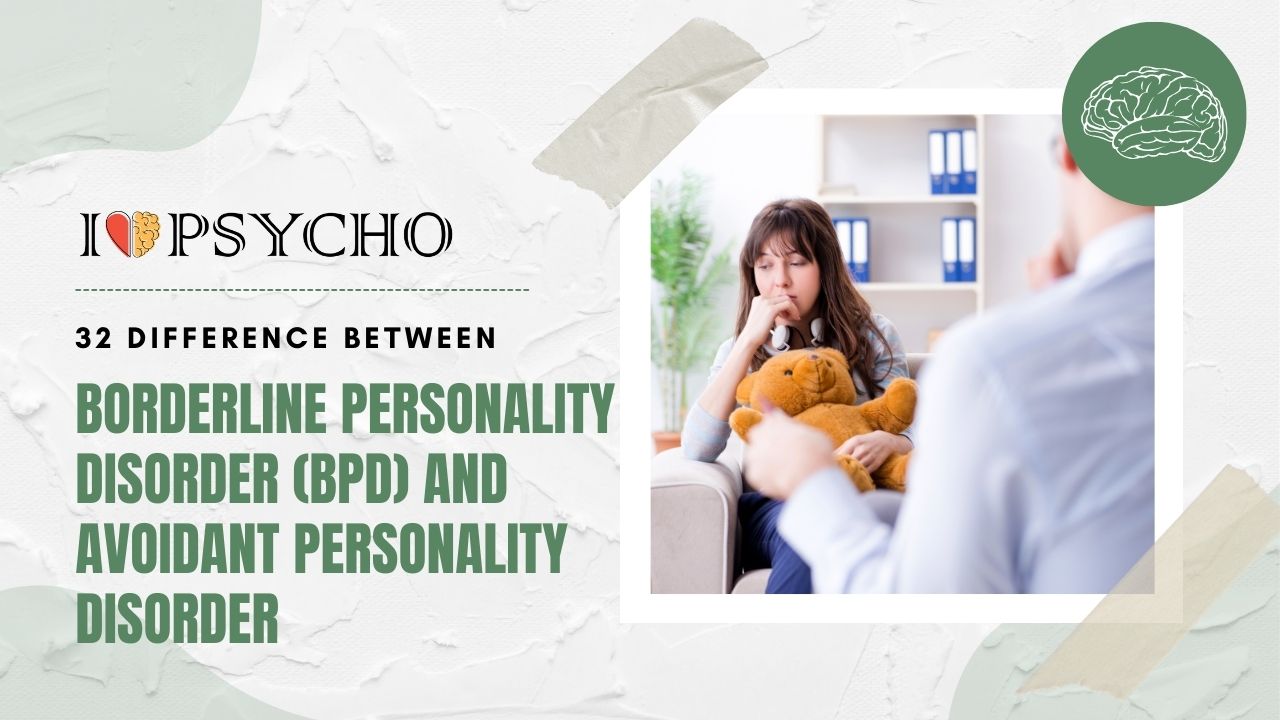Borderline and Avoidant Personality Disorders (BPD and AvPD) have different behaviors and emotions. Understanding these variances is essential for appropriate diagnosis and treatment, despite their similarities. Interpersonal interactions, self-image, and emotions are strong and unstable in BPD. Impulsivity, self-destruction, and abandonment dread are common in BPD. Mental illness, identity issues, and self-harm like cutting may plague them. BPD is characterized by emotional dysregulation, where powerful emotions including anger, despair, and anxiety can soar. Stress might cause dissociation in these people due to their fragile self-identity. Dialectical behavior treatment (DBT) promotes emotion management and social skills in BPD patients.
AvPD is characterized by excessive social inhibition, hypersensitivity to criticism, and a crippling fear of rejection or humiliation. AvPD sufferers may withdraw themselves to avoid judgment or humiliation. They feel inadequate and may avoid activities unless they know they will be approved. AvPD patients seldom act impulsively or self-destructively. CBT is a typical treatment for AvPD that challenges negative thought processes and improves social functioning.
AvPD and BPD vary in relationship style. Both diseases cause interpersonal issues, but BPD sufferers have tumultuous and tempestuous relationships with dramatic ups and downs, whereas AvPD sufferers avoid relationships out of fear of rejection. AvPD fears criticism and humiliation, whereas BPD fears abandonment and runs to avoid it.
Borderline and Avoidant Personality Disorders are separate mental health diseases with different symptoms and treatments. AvPD is characterized by social avoidance, hypersensitivity to criticism, and a fear of rejection, whereas BPD describes emotional instability, impulsivity, and abandonment. Managing symptoms and improving quality of life requires accurate diagnosis and customized treatment regimens for various conditions.
|
S.No. |
Aspect |
BPD (Borderline Personality Disorder) |
APD (Avoidant Personality Disorder) |
|
1 |
Definition |
Affective instability and impulsivity |
Social inhibition and extreme sensitivity to criticism |
|
2 |
Core Feature |
Emotional dysregulation |
Social withdrawal and avoidance |
|
3 |
Relationships |
Intense and unstable relationships |
Difficulty forming close relationships |
|
4 |
Fear of Abandonment |
Common |
Rare |
|
5 |
Self-Image |
Unstable self-identity |
Low self-esteem and self-doubt |
|
6 |
Mood Swings |
Frequent and intense mood swings |
Generally stable mood |
|
7 |
Impulsivity |
Impulsive behaviors (e.g., self-harm) |
Lack of impulsivity |
|
8 |
Self-Harm |
Often present |
Rare |
|
9 |
Suicidal Behavior |
Frequent suicidal gestures/attempts |
Less frequent suicidal tendencies |
|
10 |
Rejection Sensitivity |
Present but different from APD |
Core feature |
|
11 |
Loneliness |
Often experienced |
Central theme |
|
12 |
Social Anxiety |
Related but distinct |
Central feature |
|
13 |
Identity Disturbance |
Prominent feature |
Less prominent |
|
14 |
Emotional Reactivity |
High emotional reactivity |
Low emotional reactivity |
|
15 |
Impaired Empathy |
Often observed |
Not a defining feature |
|
16 |
Attention-Seeking |
More likely |
Avoids attention |
|
17 |
Trust Issues |
Often struggles with trust |
Fearful of rejection |
|
18 |
Treatment Approach |
Dialectical Behavior Therapy (DBT) |
Cognitive-Behavioral Therapy (CBT) |
|
19 |
Cognitive Patterns |
Black-and-white thinking |
Hypervigilance to criticism |
|
20 |
Emotional Dysregulation |
Core feature |
Not a core feature |
|
21 |
Anxiety |
Often co-occurs |
Central to the disorder |
|
22 |
Paranoid Thoughts |
Occasional |
Not a typical feature |
|
23 |
Self-Isolation |
May withdraw or isolate temporarily |
Frequent desire for isolation |
|
24 |
Risky Behaviors |
More likely to engage in risky acts |
Avoids risky situations |
|
25 |
Self-Criticism |
Self-critical but in different ways |
Self-critical in social contexts |
|
26 |
Fear of Criticism |
Sensitive to criticism but not core |
Central fear |
|
27 |
Emotional Lability |
Prominent |
Less prominent |
|
28 |
Impaired Sense of Self |
Unstable self-concept |
Low self-worth and identity issues |
|
29 |
Mood Disorders |
Often co-occur |
Less frequent |
|
30 |
Behavioral Dyscontrol |
Frequent impulsive actions |
Tends to avoid confrontations |
|
31 |
Comorbidity |
Substance abuse, eating disorders, etc. |
Social anxiety disorder, depression, etc. |
|
32 |
Onset |
Usually in late teens or early adulthood |
Typically during childhood or adolescence |
Frequently Asked Questions (FAQs)
Q1: What distinguishes BPD from AvPD?
BPD and AvPD are separate mental illnesses. In BPD, emotional instability, impulsivity, and abandonment dread are present. BPD sufferers typically have mood swings, identity issues, and self-harm. In contrast, AvPD is characterized by excessive social restraint, hypersensitivity to criticism, and rejection dread. AvPD sufferers avoid socializing to avoid embarrassment.
Q2: How do these conditions affect relationships?
BPD sufferers have volatile, passionate relationships with dramatic ups and downs. Clinginess and avoidance of being alone might result from abandonment anxiety. Instead, persons with AvPD avoid deep interactions out of fear of judgment and rejection. Avoidance can lead to social isolation and reluctance to interact.
Q3: What are common BPD symptoms?
Emotional dysregulation, impulsivity, unstable self-identity, self-destructive behaviors, and severe abandonment dread are BPD symptoms. BPD sufferers may also dissociate under intense stress. A mood swing and quick self-image change characterize this illness.
Q4: What are some common AvPD symptoms?
AvPD causes social inhibition, fear of criticism, and social avoidance. AvPD sufferers typically feel inadequate and are sensitive to criticism. They may shun rejection or humiliation-prone hobbies and relationships.
Q5: What are common BPD/AvPD treatments?
DBT, which improves emotion control and interpersonal skills, is widely used to treat BPD. This helps BPD patients handle powerful emotions and decrease self-harm. CBT is often used for AvPD. CBT helps people change negative thinking habits and improve social functioning. BPD mood stabilizers and AvPD antidepressants may be used to treat certain symptoms. Individuals’ symptoms and demands determine the treatment, which is generally adapted to each disorder’s particular issues.









